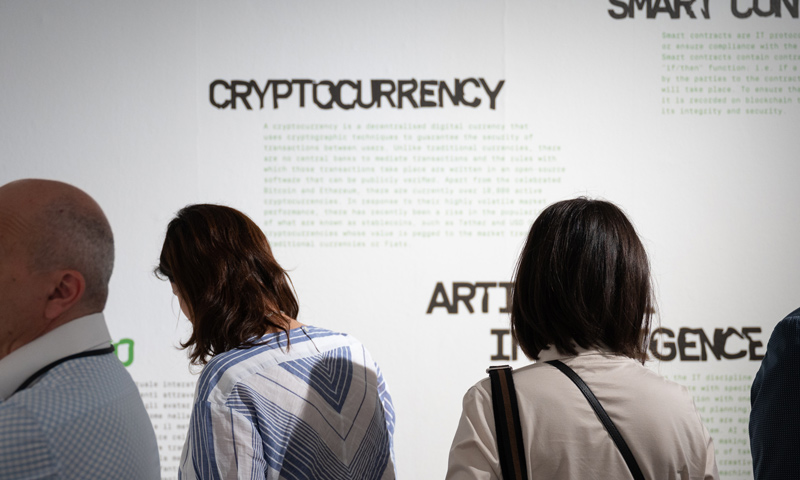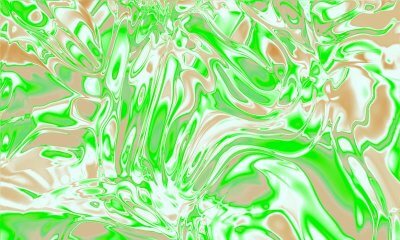
For the exhibition Let’s Get Digital! we have collected a list of terms that are fundamental to understanding the world of crypto art, with the aim of clarifying some concepts such as NFT, blockchain, cryptocurrency and smart contract.
Along with the glossary, we have chosen some publications to delve deeper into the world of digital art. The books in the list can be consulted in the exhibition.
The term digital art refers to works of created or presented using digital technologies. The first examples date back to the 1960s but the practice has evolved in parallel with the development of technology and the creation of software dedicated to the creation and enjoyment of works of art. Over the decades digital graphics in particular have developed massively and at great speed, going from 2D to 3D and on to augmented and virtual reality in a context of ever greater interaction with the audience. In recent years digital has acquired a new artistic and market values thanks to the rise of the Cryptoart movement.
Cryptoart (also known as cryptographic art) is an art movement devoted to the creation of digital works of art linked to blockchain technology which makes it possible to own, transfer and sell a work of art in a cryptographically secure and verifiable manner. In 2017 the first blockchain systems also became accessible to a whole new generation of artists close to the tech world who instantly intuited their potential, experimenting the creation works of art based on digital illustration and programming.
A blockchain is a digital data record documenting changes of ownership of digital items among different players. This record has the specific characteristic of being shared and unchangeable. The data is grouped into “blocks” connected in chronological order and distributed in a decentralized archive. Specific feature is that the record cannot be modified, only expanded. Once created, blocks can no longer be altered or eliminated but they can be added to each time a transaction takes place. This technology was first introduced in 2008 as an IT structure underpinning the Bitcoin cryptocurrency by an anonymous inventor (or group of inventors) going by the pseudonym of Satoshi Nakamoto. The most commonly used blockhains include Ethereum, still one of the most widespread in the art world. The exponential growth of interest in this new technology has triggered strong criticism as to its sustainability, given its high energy consumption. New, greener chains have recently seen the light of day, including Polygon, Algorand and Tezos whose energy footprint is over 90% less than that of Ethereum of the Bitcoin.
An NFT (an acronym for Non-Fungible Token) is a digital certificate testifying to the characteristics, originality and single ownership of a physical or digital asset, registered in unalterable cryptographic records based on blockchain technology. An item certified with an NFT is original and non-interchangeable: it is not a duplicate or a reproduction. Thus an NFT is a tool for tracing the ownership of digital files. Whoever buys one is not buying the copyright to the item but a certificate allowing him or her to prove its ownership. The first artwork ever recorded on a blockchain was Quantum, created in 2014 by the artist Kevin McCoy who chose to record his work as an NFT in order to make the file unique, traceable and exchangeable.
To create, keep, buy or sell NFT’s and cryptocurrencies (such as Bitcoins or Ethereums) you need a digital wallet. This is an application that is used to memorise and keep cryptocurrencies and NFTs. The wallet must be compatible with the blockchain on which the NFT has been created. The ERC-721 token on the blockchain of Ethereum is the standard one, widely used by the creators of digital artworks in single editions.
The act of publishing an NFT certificate on a blockchain is known as minting. Once minted, an NFT acquires specific characteristics such as uniqueness (in the sense of a single edition) or as being part of an edition based on the type of standard chosen for its creation.
Smart contracts are IT protocols that facilitate, verify or ensure compliance with the execution of a contract. Smart contracts contain contractual clauses that follow the “if/then” function: i.e. if a given condition predetermined by the parties to the contract occurs, then an agreed action will take place. To ensure that the contract is not altered, it is recorded on blockchain technology, thus guaranteeing its integrity and security.
A cryptocurrency is a decentralised digital currency that uses cryptographic techniques to guarantee the security of transactions between users. Unlike traditional currencies, there are no central banks to mediate transactions and the rules with which those transactions take place are written in an open-source software that can be publicly verified. Apart from the celebrated Bitcoin and Ethereum, there are currently over 10,000 active cryptocurrencies. In response to their highly volatile market performance, there has recently been a rise in the popularity of what are known as stablecoins, such as Tether and USD Coin, cryptocurrencies whose value is pegged to the market trend of traditional currencies or Fiats.
Artificial Intelligence (AI) is the IT discipline that studies the development of hardware and software with specific capabilities typical of the human being (interaction with one’s surroundings, learning and adaptation, reasoning and planning). AI is based on algorithms, a group of instructions that are applied in order to perform an action or to resolve a problem. AI systems are capable of performing tasks independently and of making decisions typical of human beings and thus potentially also of taking their place. In the art field that translates into the creative possibility of having a dialogue between a man and a machine in which an artificial assistant can become the co-author of a work of art.
The metaverse is an interactive virtual space shared over the Internet and accessible to users via an avatar. Avatars can move freely in this three-dimensional space, interacting to each other and engaging in activities like in the real world. Physical space and the metaverse can link up through the use of a simply mobile phone or computer, or through more immersive experiences using such devices as virtual reality visors. The word metaverse was first used in a sci-fi novel entitled Snow Crash (1992), in which author Neal Stephenson envisaged the birth of a virtual immersive world populated by avatars. The Second Life (2003) and Minecraft (2009) platforms may be considered the first examples of the metaverse. Metaverses have been created in recent years based on blockchain technology, for example Decentraland and The Sandbox. Mark Zuckerberg has recently rebranded his company Facebook as Meta Inc, intuiting the potential development of the phenomenon in the social media.
We are all gonna make it.
Filippo Annunziata, Andrea Corso, NFT. L’arte e il suo doppio. Non fungible token: l’importanza delle regole, oltre i confini dell’arte, Milano, Montabone, 2021
Daniel Arsham, Larry Warsh (a cura di), Arsham-isms, Princeton, Princeton University Press, 2021
David Balzer, Curationism: How Curating Took Over the Art World and Everything Else, London, Pluto Press, 2015
Alice Barale, Arte e intelligenza artificiale, Milano, Jaka Book, 2020
Marc Beckman, The Comprehensive Guide to NFTs, Digital Artwork, and Blockchain Technology, New York, Skyhorse Publishing, 2022
Jay David Bolter, The Digital Plenitude, London, MIT Press Ltd., 2019
Matt Fortnow, QuHarrison Terry, The NFT Handbook: How to Create, Sell and Buy Non-Fungible Tokens, Hoboken, John Wiley & Sons Inc., 2021
Roberto Garavaglia, Tutto sugli NFT. Crypto art, token, blockchain e loro applicazioni, Milano, Hoepli. 2022
William Gibson, Neuromante, Milano, Mondadori, 2017
Boris Groys, In the Flow. L’opera d’arte nell’epoca della sua riproducibilità digitale, Milano, Postmedia Books, 2020
Arch Hades, Fool’s Gold: Poetry and Postcards, London, Austin Macauley Publishers, 2020
Arch Hades, Paper Romance, Marylebone, Black Spring Press Ltd., 2021
Lewis Hyde, Common as Air: Revolution, Art, and Ownership, New York, Farrar, Straus & Giroux Inc., 2011
Donna J. Haraway, Manifesto cyborg. Donne, tecnologie e biopolitiche del corpo, Milano, Feltrinelli, 2021 (prima edizione 1995)
Duke Mike, Why Al Hallucinates: The Bot-Verse Begins, Global Innovation Books
Noam Nisan, Shimon Schocken, The Elements of Computing Systems: Building a Modern Computer from First Principles, London, MIT Press Ltd., 2021
Christiane Paul, Digital Art, London, Thames & Hudson Ltd., 2015
Rebecca Pedrazzi, Futuri possibili. Scenari d’arte e intelligenza artificiale, Milano, Jaka Book, 2021
Domenico Quaranta, Surfing con Satoshi. Arte, blockchain e NFT, Milano, Postmedia Books, 2021
Valentina Tanni, Memestetica. Il settembre eterno dell’arte, Roma, Produzioni Nero, 2020
